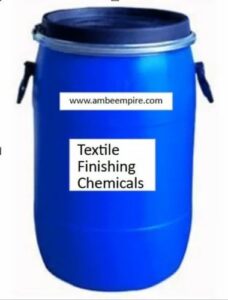Textile Finishing Chemicals
Textile finishing chemicals are essential components in the textile industry, used to enhance the properties of fabrics and improve their performance. These chemicals are applied to textiles after the dyeing process to provide various functionalities such as water repellency, wrinkle resistance, flame retardancy, and antimicrobial properties. The finishing process not only improves the aesthetic appeal of the fabric but also extends its lifespan and usability in various applications.
Uses of Textile Finishing Chemicals
- Water Repellency: Chemicals like fluoropolymers are used to create a barrier against water, making fabrics suitable for outdoor and performance wear.
- Wrinkle Resistance: Resins and softeners are applied to fabrics to reduce creasing and maintain a smooth appearance after washing.
- Flame Retardancy: Specialized chemicals are used to treat fabrics, making them resistant to ignition and slowing down the spread of flames, crucial for safety in various industries.
- Antimicrobial Properties: Finishing agents that inhibit the growth of bacteria and fungi are applied to textiles, making them ideal for medical and hygiene applications.
- Stain Resistance: Chemicals that provide stain-repellent properties are used to keep fabrics looking clean and new for longer periods.
- Softening: Softening agents are added to enhance the tactile feel of fabrics, making them more comfortable to wear.
Technical Data of Textile Finishing Chemicals
| Property | Description | Example Chemicals |
|---|---|---|
| Chemical Type | Various types including resins, fluoropolymers, and softeners | Polyurethane, Silicones, Fluorocarbons |
| Application Method | Can be applied through padding, spraying, or exhaustion | Padding for water repellency, spraying for softening |
| Curing Temperature | Varies based on chemical type, typically between 100°C to 180°C | 120°C for wrinkle-resistant resins |
| pH Level | Generally ranges from 4 to 8 for optimal performance | pH 6 for antimicrobial finishes |
| Solubility | Water-soluble or solvent-based depending on the application | Water-soluble softeners, solvent-based flame retardants |
| Durability | Varies; some finishes are permanent while others are temporary | Permanent water repellents vs. wash-off softeners |
| Environmental Impact | Biodegradable options available; some may contain harmful substances | Eco-friendly fluoropolymers vs. traditional fluorocarbons |
Conclusion
Textile finishing chemicals play a crucial role in enhancing the functionality and durability of fabrics. By understanding their uses and technical specifications, manufacturers can select the appropriate chemicals to meet the specific needs of their products, ensuring high-quality textiles that perform well in various applications.

